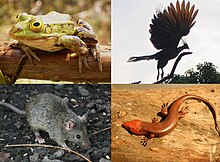| Tetrapodomorpha | |
|---|---|

| |
| Life restoration of Panderichthys | |

| |
| Modern tetrapods | |
| Scientific classification | |
| Domain: | Eukaryota |
| Kingdom: | Animalia |
| Phylum: | Chordata |
| Clade: | Sarcopterygii |
| Clade: | Rhipidistia |
| Clade: | Tetrapodomorpha Ahlberg, 1991 |
| Subgroups | |
See also below. | |
Tetrapodomorpha (also known as Choanata[3]) is a clade of vertebrates consisting of tetrapods (four-limbed vertebrates) and their closest sarcopterygian relatives that are more closely related to living tetrapods than to living lungfish. Advanced forms transitional between fish and the early labyrinthodonts, such as Tiktaalik, have been referred to as "fishapods" by their discoverers, being half-fish, half-tetrapods, in appearance and limb morphology. The Tetrapodomorpha contains the crown group tetrapods (the last common ancestor of living tetrapods and all of its descendants) and several groups of early stem tetrapods, which includes several groups of related lobe-finned fishes, collectively known as the osteolepiforms. The Tetrapodomorpha minus the crown group Tetrapoda are the stem Tetrapoda, a paraphyletic unit encompassing the fish to tetrapod transition.
- ^ Lu, J.; Zhu, M.; Long, J. A.; Zhao, W.; Senden, T. J.; Jia, L.; Qiao, T. (2012). "The earliest known stem-tetrapod from the Lower Devonian of China". Nature Communications. 3: 1160. Bibcode:2012NatCo...3.1160L. doi:10.1038/ncomms2170. hdl:1885/69314. PMID 23093197.
- ^ Merck, John. "And Now For Something Completely Different: Sarcopterygii".
- ^ Zhu Min; Schultze, Hans-Peter (11 September 2002). Per Erik Ahlberg (ed.). Major Events in Early Vertebrate Evolution. CRC Press. p. 296. ISBN 978-0-203-46803-6. Retrieved 5 August 2015.